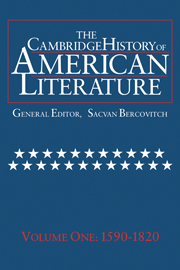Book contents
- Frontmatter
- Introduction
- THE LITERATURE OF COLONIZATION
- NEW ENGLAND PURITAN LITERATURE
- BRITISH-AMERICAN BELLES LETTRES
- THE AMERICAN ENLIGHTENMENT, 1750–1820
- 1 Finding the Revolution
- 2 What is Enlightenment? Some American Answers
- 3 Religious Voices
- 4 Writing the Revolution
- 5 The Literature of Public Documents
- 6 The Limits of Enlightenment
- THE LITERATURE OF THE REVOLUTIONARY AND EARLY NATIONAL PERIODS
- Chronology
- Bibliography
- Index
1 - Finding the Revolution
from THE AMERICAN ENLIGHTENMENT, 1750–1820
Published online by Cambridge University Press: 28 March 2008
- Frontmatter
- Introduction
- THE LITERATURE OF COLONIZATION
- NEW ENGLAND PURITAN LITERATURE
- BRITISH-AMERICAN BELLES LETTRES
- THE AMERICAN ENLIGHTENMENT, 1750–1820
- 1 Finding the Revolution
- 2 What is Enlightenment? Some American Answers
- 3 Religious Voices
- 4 Writing the Revolution
- 5 The Literature of Public Documents
- 6 The Limits of Enlightenment
- THE LITERATURE OF THE REVOLUTIONARY AND EARLY NATIONAL PERIODS
- Chronology
- Bibliography
- Index
Summary
Understanding the American Revolution is a literary pursuit, and John Adams assumes as much in his own famous summary of the event. “The Revolution,” Adams insists in 1818, “was in the minds and hearts of the people,” and those who would seek it must collect and search “all the records, pamphlets, newspapers, and even handbills, which in any way contributed to change the temper and views of the people.” By concentrating on this change in ideas, Adams makes “the real American Revolution,” as he calls it, the central event of the American Enlightenment, and he turns comprehension of it into a permanent test of cultural well-being. In urging this understanding upon “young men of letters in all of the States,” he also warns them against superficial explanations that stress “the gloriole of individual gentlemen.” The transformations in thought that bind Americans together in 1776 and after take place beneath the surface of events. Only by a diligent search can one hope to find the deeper truth of “radical change in the principles, opinions, sentiments, and affections of the people.”
This challenge, already problematic in 1818, remains the challenge of today. The task is to recover as much as possible of the Revolution, itself the greatest literary achievement of eighteenth-century America, while keeping in mind the gaps between surviving word and original thought, text and lost context, assertion and expectation, story and event. If “the real American Revolution” resists a narrative of heroics to reside elsewhere – in the minds and hearts of the people – how does one reach that level through extant writings?
- Type
- Chapter
- Information
- The Cambridge History of American Literature , pp. 345 - 367Publisher: Cambridge University PressPrint publication year: 1994

